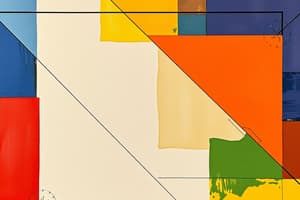Podcast
Questions and Answers
What is Postulate 24 about?
What is Postulate 24 about?
- The area of a rectangle
- The area of a triangle
- The area of a parallelogram
- The area of a square (correct)
What does Postulate 25 state?
What does Postulate 25 state?
If two polygons are congruent, then they have the same area.
What is the Area Addition Postulate?
What is the Area Addition Postulate?
The area of a region is the sum of the areas of its nonoverlapping parts.
What does Theorem 11.1 provide information about?
What does Theorem 11.1 provide information about?
What is the definition of the base of a parallelogram?
What is the definition of the base of a parallelogram?
How is the height of a parallelogram defined?
How is the height of a parallelogram defined?
What does Theorem 11.2 state regarding parallelograms?
What does Theorem 11.2 state regarding parallelograms?
What is Theorem 11.3 about?
What is Theorem 11.3 about?
How is height defined in relation to a trapezoid?
How is height defined in relation to a trapezoid?
What does Theorem 11.4 state about trapezoids?
What does Theorem 11.4 state about trapezoids?
What does Theorem 11.5 highlight about rhombuses?
What does Theorem 11.5 highlight about rhombuses?
What does Theorem 11.6 explain about kites?
What does Theorem 11.6 explain about kites?
What relationship is described by Theorem 11.7?
What relationship is described by Theorem 11.7?
Define circumference.
Define circumference.
What does Theorem 11.8 define?
What does Theorem 11.8 define?
What is meant by arc length?
What is meant by arc length?
What does the Arc Length Corollary state?
What does the Arc Length Corollary state?
What is Theorem 11.9 related to circles?
What is Theorem 11.9 related to circles?
What is Theorem 11.10 about?
What is Theorem 11.10 about?
What defines the sector of a circle?
What defines the sector of a circle?
What does Theorem 11.11 state about regular polygons?
What does Theorem 11.11 state about regular polygons?
What is the radius of a polygon?
What is the radius of a polygon?
Define the apothem of a polygon.
Define the apothem of a polygon.
What is a central angle of a regular polygon?
What is a central angle of a regular polygon?
What is probability?
What is probability?
What does geometric probability involve?
What does geometric probability involve?
Flashcards are hidden until you start studying
Study Notes
Area Postulates and Theorems
- Area of a Square Postulate: Area is the square of the side length.
- Area Congruence Postulate: Congruent polygons have equal areas.
- Area Addition Postulate: Total area equals the sum of nonoverlapping areas.
Area of Common Shapes
- Area of a Rectangle: Calculated as the product of base and height (A = base × height).
- Area of a Parallelogram: Given by A = b × h, where b is the base and h is the height.
- Area of a Triangle: Computed as A = 1/2 × base × height.
- Area of a Trapezoid: A = 1/2 × height × (base1 + base2).
- Area of a Rhombus: A = 1/2 × d1 × d2, with d1 and d2 being the diagonals.
- Area of a Kite: Also A = 1/2 × d1 × d2.
Areas of Similar Polygons
- Similar polygons have areas in the ratio of the squares of their corresponding sides (a^2:b^2).
Circle Measurements
- Circumference: The distance around a circle, calculated as C = πd or C = 2πr.
- Arc Length: A portion of the circumference.
- Arc Length Corollary: The length of an arc compared to the full circumference is proportional to the measure of the arc over 360 degrees.
Area of a Circle and Sector
- Area of a Circle: A = πr², where r is the radius.
- Area of a Sector: The area ratio is equivalent to the intercepted arc measure over 360 degrees.
Regular Polygons
- Area of a Regular Polygon: Calculated as A = 1/2 × apothem × perimeter (A = 1/2aP), where P is the perimeter and A is the apothem.
- Radius of the Polygon: Refers to the radius of the circumscribed circle.
- Apothem: The distance from the center to a side of the polygon.
Geometry and Probability
- Probability: Indicates the likelihood of an event occurring.
- Geometric Probability: Involves a ratio that relates to geometric measurements like area or length.
Studying That Suits You
Use AI to generate personalized quizzes and flashcards to suit your learning preferences.




